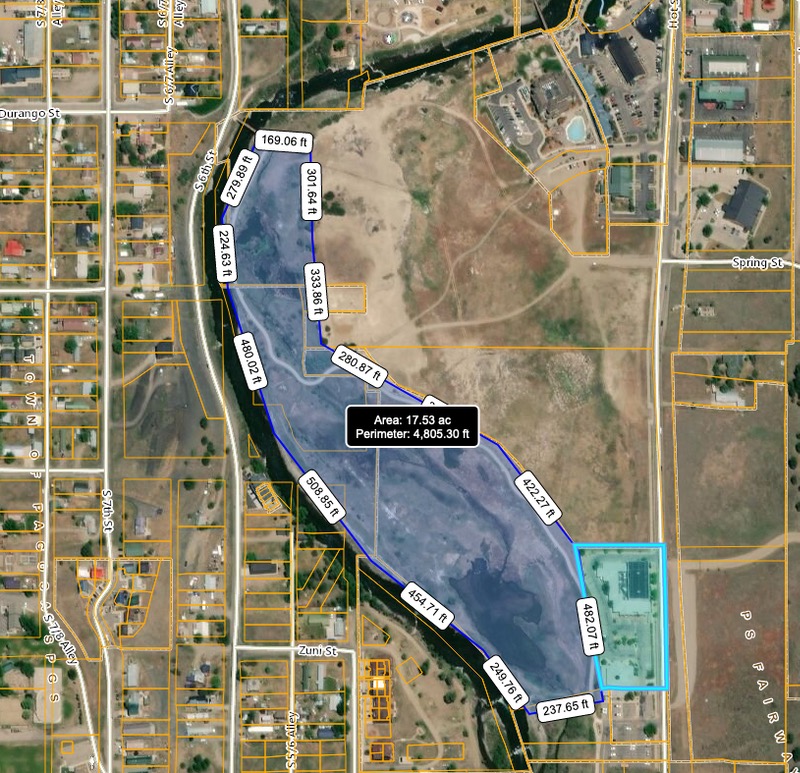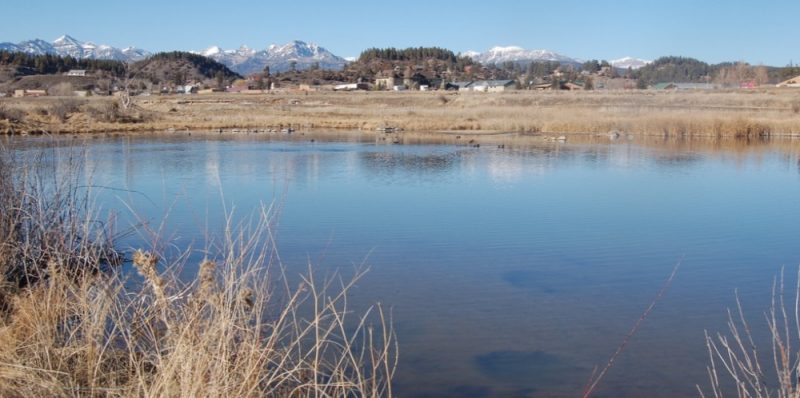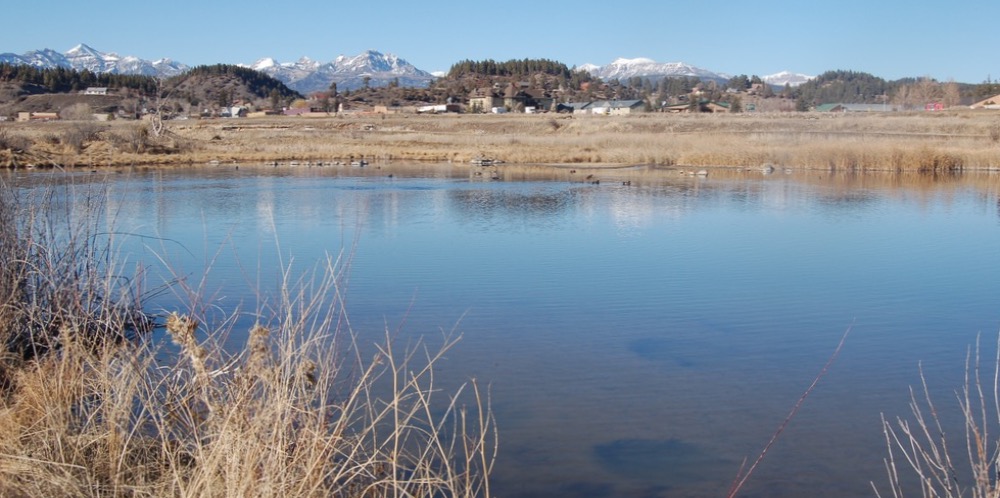If you stand at the windows in the upstairs Council Chambers, in the Pagosa Springs Town Hall, you have an excellent view of the Riverwalk Wetlands.
An excellent view of what some would describe as a ‘unique wetlands.’
A couple of decades ago, a new Town Hall was built near the southern end of Hot Springs Boulevard, largely in hopes of encouraging commercial or mixed use development along a somewhat-improved Boulevard — previously an unremarkable dirt road known as Light Plant Road. Much of the imagined development would have taken place on 27 vacant acres on the west side of the Boulevard, adjacent to the Riverwalk Wetlands…
…If the scheme had actually generated some development.
In the map below, the 2.5-acre Town Hall property is indicated in pale blue, overlooking the 17-acre Riverwalk Wetlands, indicated in a slightly darker blue. Much of the surrounding property remains vacant, two decades later.

Most of the wetlands — the southernmost 10 acres — once belonged to developers Matt Mees and Bill Dawson, who had purchased it from the Lynn family as part of a larger property purchase. Mr. Mees and Mr. Dawson also owned the Springs Resort at the time of this large purchase — 1995 — and it appears they paid $360,000 for about 37 acres of mixed travertine meadow and wetlands.
A great site for a downtown subdivision, someday? … and perhaps an expansion of the Springs Resort?
It appears (from County Assessor data) that, in 1998, the Pagosa Springs Resort Company sold 10 acres of wetlands to the Town government, for $609,000. The wetlands was essentially useless for development, I would assume, due to the strict federal regulations that protect wetlands, so selling 10 ‘useless’ acres to Mayor Ross Aragon’s Town government for almost twice what the Springs Partners had paid for 37 acres probably seemed like a good idea.
The Town government then constructed a fancy new sidewalk on Hot Springs Boulevard — along the remaining 27 acres still in private ownership — perhaps as a little ‘thank you’ for the opportunity to purchase the wetlands.
Another purchase took place in 2010, when the Town government bought about 4 acres of riverside wetlands from the Watters family for $121,550. Several acres of wetlands, north of the Watters property, are still held in private ownership, but that property has granted a trail easement to accommodate the Riverwalk Trail.
From what I can tell, as an uninformed observer and a user of the Riverwalk Trail, the water that feeds these wetlands flows gently downhill from the north to the south — as does the adjacent San Juan River. Just how much of that water is warm, geothermal water? It would appear that no one really knows…

A roomful of citizen activists gathered at Town Hall on February 27, to participate in a Town Council work session and to show their concern for the Riverwalk Wetlands. We’re listening here to a gentleman names Randy McCormick, speaking to the Town Council during a February 27 work session. From the brief resume provided to the Town Council:
[Mr. McCormick] served as Environmental Manager at the National Estuarine Research Reserve in Naples, Florida. This NOAA affiliated program is mandated to protect 110,000 acres of coastal wetlands in the western Everglades. He has been a lead instructor in the Florida Master Naturalist Program, is a Certified Interpretive Guide, and developed and ran the Eco-Tour program at the Reserve. He is currently retired and lives full-time in Pagosa Springs.
“Hydrology. It’s a pretty exciting topic, I know,” Mr. McCormick smiled.
“One of the things I have learned — working with a fairly significant wetlands called the ‘Everglades’ — is that they are incredibly complex systems. This little wetlands is actually particularly complex. So it’s not an easy task to try and manage. The hydrology here is particularly unique.
“Water is the life blood of a wetlands… and it’s very easy to divert water in such a way, that in a very short period of time, it’s completely destroyed. That has happened all over the world.
“Three things actually determine the life or death of a wetlands. Water quality. Water quantity. And the timing of the inflows. Those are the three things you’ve got to get right, if you want to maintain a healthy wetlands anywhere on Planet Earth.
“Water quality… there are four sources of water feeding into this wetlands. Precipitation. There’s a shallow aquifer. Fresh water coming in from the river during high flow events. Those are all fresh water sources.
“But there’s a fourth source that’s really unique. The hot springs.
“Most of the wetlands you find in this region, certainly in Colorado, don’t have that. And that makes this one particularly unusual. The first three water sources, the fresh water sources, are typical to wetlands. But that fourth one, that hot water, is mineralized water. A very different quality of water… Mineralized water leads to the formation of a community of plants adapted to that kind of water.”
As Mr. McCormick went on the explain, the biological environment of plants, insects, birds and other wetlands inhabitants may not be the same mix typically found in a Colorado wetlands.
“The other thing we need to consider is quantity. The quantity of water available to this wetlands, particularly here, is variable — seasonally and year to year. Obviously, in the middle of winter, you’ve got a lot of water locked up in snow and ice. Come springtime, it’s released. And this varies from year to year. We’ve got dry years and we’ve got wet years. That variability is something that the animals and plants out there have adapted to over millennia. That’s a normal process. They’re okay with it, essentially.
“We need to figure out how much water, of what type, is coming from where, in order to protect this place.
“We don’t know that…”

